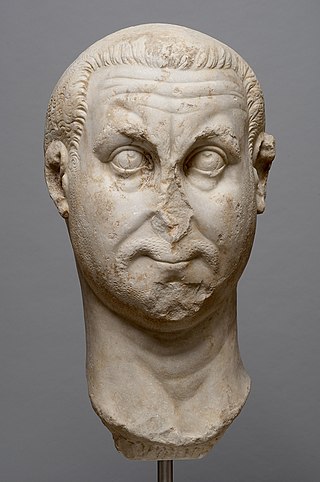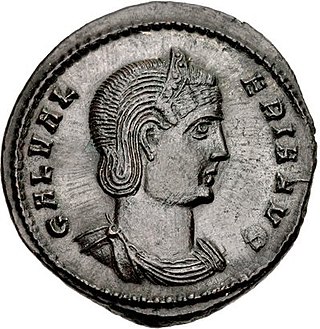
The Tetrarchy was the system instituted by Roman emperor Diocletian in 293 AD to govern the ancient Roman Empire by dividing it between two emperors, the augusti, and their junior colleagues and designated successors, the caesares.
The 310s decade ran from January 1, 310, to December 31, 319.

Year 313 (CCCXIII) was a common year starting on Thursday of the Julian calendar. At the time, it was known as the Year of the Consulship of Constantinus and Licinianus. The denomination 313 for this year has been used since the early medieval period, when the Anno Domini calendar era became the prevalent method in Europe for naming years. This year is notable for ending of the persecution of Christians in the Roman Empire.

Year 307 (CCCVII) was a common year starting on Wednesday of the Julian calendar. At the time, it was known as the Year of the Consulship of Severus and Maximinus. The denomination 307 for this year has been used since the early medieval period, when the Anno Domini calendar era became the prevalent method in Europe for naming years.

Year 311 (CCCXI) was a common year starting on Monday of the Julian calendar. At the time, it was known as the Year of the Consulship of Valerius and Maximinus. The denomination 311 for this year has been used since the early medieval period, when the Anno Domini calendar era became the prevalent method in Europe for naming years.

Year 315 (CCCXV) was a common year starting on Saturday of the Julian calendar. At the time, it was known in Rome as the Year of the Consulship of Constantinus and Licinianus. The denomination 315 for this year has been used since the early medieval period, when the Anno Domini calendar era became the prevalent method in Europe for naming years.

Galerius Valerius Maximianus was Roman emperor from 305 to 311. While acting as Caesar under Emperor Diocletian, Galerius obtained victory warring against the Persian Sassanian Empire, defeating Narseh at the battle of Satala in 298 and possibly sacking the Sassanian capital of Ctesiphon in 299. He also campaigned across the Danube against the Carpi, defeating them in 297 and 300. Although he was a staunch opponent of Christianity, Galerius ended the Diocletianic Persecution when he issued the Edict of Toleration in Serdica (Sofia) in 311.

Valerius Licinianus Licinius was Roman emperor from 308 to 324. For most of his reign, he was the colleague and rival of Constantine I, with whom he co-authored the Edict of Milan that granted official toleration to Christians in the Roman Empire. He was finally defeated at the Battle of Chrysopolis, and was later executed on the orders of Constantine I.

Galerius Valerius Maximinus Daza, born as Daza, was Roman emperor from 310 to 313. He became embroiled in the civil wars of the Tetrarchy between rival claimants for control of the empire, in which he was defeated by Licinius. A committed pagan, he engaged in one of the last persecutions of Christians, before issuing an edict of tolerance granting Christians their freedoms back near his death. Maximinus Daza is the last to be referred as Pharaoh of Egypt.

Marcus Aurelius Valerius Maxentius was a Roman emperor from 306 until his death in 312. Despite ruling in Italy and North Africa, and having the recognition of the Senate in Rome, he was not recognized as a legitimate emperor by his fellow emperors.

The Edict of Milan was the February, AD 313 agreement to treat Christians benevolently within the Roman Empire. Western Roman Emperor Constantine I and Emperor Licinius, who controlled the Balkans, met in Mediolanum and, among other things, agreed to change policies towards Christians following the edict of toleration issued by Emperor Galerius two years earlier in Serdica. The Edict of Milan gave Christianity legal status and a reprieve from persecution but did not make it the state church of the Roman Empire, which occurred in AD 380 with the Edict of Thessalonica, when Nicene Christianity received normative status.

Eutropia was a Roman empress of Syrian origin, the wife of Emperor Maximian.

The Diocletianic or Great Persecution was the last and most severe persecution of Christians in the Roman Empire. In 303, the emperors Diocletian, Maximian, Galerius, and Constantius issued a series of edicts rescinding Christians' legal rights and demanding that they comply with traditional religious practices. Later edicts targeted the clergy and demanded universal sacrifice, ordering all inhabitants to sacrifice to the gods. The persecution varied in intensity across the empire—weakest in Gaul and Britain, where only the first edict was applied, and strongest in the Eastern provinces. Persecutory laws were nullified by different emperors at different times, but Constantine and Licinius' Edict of Milan in 313 has traditionally marked the end of the persecution.
The Battle of Tzirallum was part of the civil wars of the Tetrarchy fought on 30 April 313 between the Roman armies of emperors Licinius and Maximinus. The battle location was on the "Campus Serenus" at Tzirallum, identified as the modern-day town of Çorlu, in Tekirdağ Province, in the Turkish region of Eastern Thrace. Sources put the battle between 18 and 36 Roman miles from Heraclea Perinthus, the modern-day town of Marmara Ereğlisi.

Galeria Valeria was the daughter of Roman Emperor Diocletian and wife of his co-emperor Galerius.

The civil wars of the Tetrarchy were a series of conflicts between the co-emperors of the Roman Empire, starting from 306 AD with the usurpation of Maxentius and the defeat of Severus to the defeat of Licinius at the hands of Constantine I in 324 AD.
Flavius Severianus was the son of the Roman Emperor Flavius Valerius Severus.
The gens Galeria was a Roman family of Imperial times. The family first rose to prominence under the Julio-Claudian dynasty, but the most illustrious person of the name was the emperor Galerius, one of the heirs of Diocletian, who reigned from AD 305 to 311, although he cannot have been a direct descendant of the earlier family.
Candidianus was the son of the Roman Emperor Galerius and adoptive son of Galeria Valeria, the wife of Galerius and daughter of Diocletian.

The Conference of Carnuntum was a gathering of ancient Roman rulers on 11 November 308, intended to stabilize the power-sharing arrangement known as the Tetrarchy. It was convened by the Eastern augustus (emperor) Galerius in the city of Carnuntum, which at the time was located in the Roman province of Pannonia Prima. A dispute over the title of augustus in the West had been ongoing since the previous year, when consecutive invasions by Severus II and Galerius had failed to recover Italy from the usurpers Maxentius and Maximian. Present at the conference were the retired Diocletian, and his former colleague, Maximian.

















